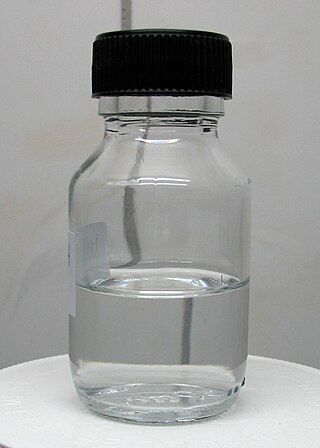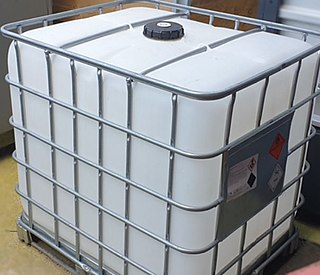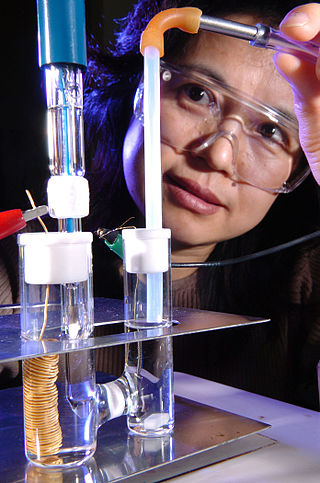
Methanol is an organic chemical compound and the simplest aliphatic alcohol, with the chemical formula CH3OH. It is a light, volatile, colorless and flammable liquid with a distinctive alcoholic odour similar to that of ethanol . Methanol acquired the name wood alcohol because it was once produced chiefly by the destructive distillation of wood. Today, methanol is mainly produced industrially by hydrogenation of carbon monoxide.

In chemistry and manufacturing, electrolysis is a technique that uses direct electric current (DC) to drive an otherwise non-spontaneous chemical reaction. Electrolysis is commercially important as a stage in the separation of elements from naturally occurring sources such as ores using an electrolytic cell. The voltage that is needed for electrolysis to occur is called the decomposition potential. The word "lysis" means to separate or break, so in terms, electrolysis would mean "breakdown via electricity".

Formic acid, systematically named methanoic acid, is the simplest carboxylic acid, and has the chemical formula HCOOH and structure H−C(=O)−O−H. It is an important intermediate in chemical synthesis and occurs naturally, most notably in some ants. Esters, salts and the anion derived from formic acid are called formates. Industrially, formic acid is produced from methanol.
Artificial photosynthesis is a chemical process that biomimics the natural process of photosynthesis to convert sunlight, water, and carbon dioxide into carbohydrates and oxygen. The term artificial photosynthesis is commonly used to refer to any scheme for capturing and storing the energy from sunlight in the chemical bonds of a fuel. Photocatalytic water splitting converts water into hydrogen and oxygen and is a major research topic of artificial photosynthesis. Light-driven carbon dioxide reduction is another process studied that replicates natural carbon fixation.

The methanol economy is a suggested future economy in which methanol and dimethyl ether replace fossil fuels as a means of energy storage, ground transportation fuel, and raw material for synthetic hydrocarbons and their products. It offers an alternative to the proposed hydrogen economy or ethanol economy, although these concepts are not exclusive. Methanol can be produced from a variety of sources including fossil fuels as well as agricultural products and municipal waste, wood and varied biomass. It can also be made from chemical recycling of carbon dioxide.
In electrochemistry, electrosynthesis is the synthesis of chemical compounds in an electrochemical cell. Compared to ordinary redox reactions, electrosynthesis sometimes offers improved selectivity and yields. Electrosynthesis is actively studied as a science and also has industrial applications. Electrooxidation has potential for wastewater treatment as well.

An electrocatalyst is a catalyst that participates in electrochemical reactions. Electrocatalysts are a specific form of catalysts that function at electrode surfaces or, most commonly, may be the electrode surface itself. An electrocatalyst can be heterogeneous such as a platinized electrode. Homogeneous electrocatalysts, which are soluble, assist in transferring electrons between the electrode and reactants, and/or facilitate an intermediate chemical transformation described by an overall half reaction. Major challenges in electrocatalysts focus on fuel cells.
The electrochemical reduction of carbon dioxide, also known as CO2RR, is the conversion of carbon dioxide to more reduced chemical species using electrical energy. It represents one potential step in the broad scheme of carbon capture and utilization.
Photochemical reduction of carbon dioxide harnesses solar energy to convert CO2 into higher-energy products. Environmental interest in producing artificial systems is motivated by recognition that CO2 is a greenhouse gas. The process has not been commercialized.
Metal carbon dioxide complexes are coordination complexes that contain carbon dioxide ligands. Aside from the fundamental interest in the coordination chemistry of simple molecules, studies in this field are motivated by the possibility that transition metals might catalyze useful transformations of CO2. This research is relevant both to organic synthesis and to the production of "solar fuels" that would avoid the use of petroleum-based fuels.

An alkaline anion exchange membrane fuel cell (AAEMFC), also known as anion-exchange membrane fuel cells (AEMFCs), alkaline membrane fuel cells (AMFCs), hydroxide exchange membrane fuel cells (HEMFCs), or solid alkaline fuel cells (SAFCs) is a type of alkaline fuel cell that uses an anion exchange membrane to separate the anode and cathode compartments.
G. K. Surya Prakash is a professor of Chemistry, Chemical Engineering and Materials Science and holder of the George A. and Judith A. Olah Nobel Laureate Chair in Hydrocarbon Chemistry at the Department of Chemistry at the University of Southern California. He serves as the Director of the Loker Hydrocarbon Research Institute, where he maintains his prominent research lab. He also served as the Chairman of the Chemistry Department for four years between 2017 and 2021. He received a B.Sc. (Hons) from Bangalore University in 1972, a M.Sc. from IIT Madras in 1974 and a Ph.D. from University of Southern California in 1978 under the direction of George Olah, where he worked on characterizing stable carbocations in superacids. He also sits on several editorial boards of major scientific journals.

Carbon-neutral fuel is fuel which produces no net-greenhouse gas emissions or carbon footprint. In practice, this usually means fuels that are made using carbon dioxide (CO2) as a feedstock. Proposed carbon-neutral fuels can broadly be grouped into synthetic fuels, which are made by chemically hydrogenating carbon dioxide, and biofuels, which are produced using natural CO2-consuming processes like photosynthesis.
Liquid Light is a New Jersey-based company that develops and licenses electrochemical process technology to make chemicals from carbon dioxide (CO2). The company has more than 100 patents and patent applications for the technology that can produce multiple chemicals such as ethylene glycol, propylene, isopropanol, methyl-methacrylate and acetic acid. Funding has been provided by VantagePoint Capital Partners, BP Ventures, Chrysalix Energy Venture Capital, Osage University Partners and Sustainable Conversion Ventures. Liquid Light's technology can be used to produce more than 60 chemicals, but its first targeted process is for the production of monoethylene glycol (MEG) which has a $27 billion annual market. MEG is used to make a wide range of consumer products including plastic bottles, antifreeze and polyester fiber.

Andrzej Wieckowski was an Emeritus Professor of Chemistry at the University of Illinois at Urbana–Champaign and the North American Editor of Electrochimica Acta. He is known for his spectroscopic investigations of electrocatalysis in fuel cells and co-inventing of the direct formic acid fuel cell (DFAFC). He authored more than 300 publications, has been cited over 13,000 times and has an h-index 60. He was appointed fellow of the Electrochemical Society in 2007 and fellow of the International Society of Electrochemistry in 2009. He was awarded the US Department of Energy Prize for outstanding Scientific Accomplishment in Materials Chemistry in 1992, the ISE Jacques Tacussel Prize in 1998, the ECS David. C. Graham Award in 2003, and the ISE Gold Medal in 2007.
Dioxide Materials was founded in 2009 in Champaign, Illinois, and is now headquartered in Boca Raton, Florida. Its main business is to develop technology to lower the world's carbon footprint. Dioxide Materials is developing technology to convert carbon dioxide, water and renewable energy into carbon-neutral gasoline (petrol) or jet fuel. Applications include CO2 recycling, sustainable fuels production and reducing curtailment of renewable energy(i.e. renewable energy that could not be used by the grid).

Carbon capture and utilization (CCU) is the process of capturing carbon dioxide (CO2) from industrial processes and transporting it via pipelines to where one intends to use it in industrial processes.
Amanda Morris is an American chemist who is the Patricia Caldwell Faculty Fellow and professor of inorganic and energy chemistry at Virginia Tech. Her research considers next-generation materials for catalysis and light-harvesting. She was elected chair of the American Chemical Society Gay and Transgender Chemists and Allies committee in 2021.
Elod Lajos Gyenge is a professor of Chemical and Biological Engineering at the faculty of Applied Science in University of British Columbia in Vancouver, BC, Canada. He is also an associate member of the Clean Energy Research Center of UBC Vancouver campus. Elod Gyenge has been nominated for several teaching and research awards including Japanese Society for Promotion of Science (JSPS) Fellowship at Osaka University and the recipient of the distignshuied Elisabeth and Leslie Gould Endowed Professorship at UBC from 2007 to 2014. His research has been toward development of electrochemical systems such as fuel cells, batteries and electrosynthesis systems. He is also an appointed professor in the engineering school of Osaka University in Japan.
Krishnan Rajeshwar is a chemist, researcher and academic. He is a Distinguished University Professor and Founding Director of the Center for Renewable Energy Science & Technology at The University of Texas at Arlington.









